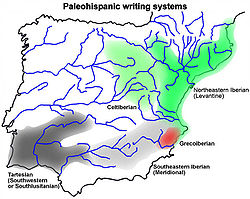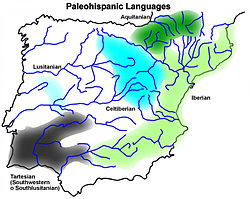| Revision as of 14:51, 23 February 2009 editTrigaranus (talk | contribs)Extended confirmed users3,471 editsm theory by geneticist A. Arnaiz-Villena, article deleted← Previous edit | Revision as of 22:54, 13 May 2009 edit undoVirginal6 (talk | contribs)289 edits Complete where Iberian scripts have been found--~~~~Next edit → | ||
| Line 17: | Line 17: | ||
| ** Non-dual variant (] and ]) | ** Non-dual variant (] and ]) | ||
| * ] | * ] | ||
| In the sense that the Iberian scripts are the scripts created for the Iberians to represent the Iberian language, the ], a separate adaptation of the ], was also an Iberian script. It was used mainly in ] and ]. Likewise, neither the ], very similar to southeastern Iberian script but used for the ], nor the ], a direct adaptation of the ] used for the ], are technically Iberian scripts. | In the sense that the Iberian scripts are the scripts created for the Iberians to represent the Iberian language, the ], a separate adaptation of the ], was also an Iberian script. It was used mainly in ] and ]. Likewise, neither the ], very similar to southeastern Iberian script but used for the ], nor the ], a direct adaptation of the ] used for the ], are technically Iberian scripts. | ||
| The northeastern Iberian script is often known simply as the '''Iberian script''', because it is the script of 95% of known Iberian inscriptions. These have been found mainly in the northeastern quadrant of the ], mostly along the coast from ] to ], but with a deep penetration on the ] valley. | The northeastern Iberian script is often known simply as the '''Iberian script''', because it is the script of 95% of known Iberian inscriptions. These have been found mainly in the northeastern quadrant of the ], mostly along the coast from ] to ], but with a deep penetration on the ] valley.Iberian script have also been found on rocks of the Canary Islands (Fuerteventura and Lanzarote).These have been called Iberian-Guanche scripts ]. | ||
| The southeastern Iberian script is poorly attested, and there are some gaps in the records: There are no positively identified symbols for /gu/, /do/, and /m/, for example. Unlike the ] the decipherment of the southeastern Iberian script is not still closed, because there are a significant group of signs without consensus value. The southeastern inscriptions have been found mainly in the southeastern quadrant of Iberia: Eastern ], ], ], ], and ]. | The southeastern Iberian script is poorly attested, and there are some gaps in the records: There are no positively identified symbols for /gu/, /do/, and /m/, for example. Unlike the ] the decipherment of the southeastern Iberian script is not still closed, because there are a significant group of signs without consensus value. The southeastern inscriptions have been found mainly in the southeastern quadrant of Iberia: Eastern ], ], ], ], and ]. | ||
Revision as of 22:54, 13 May 2009









The Iberian scripts are the Paleohispanic scripts that were used to represent the extinct Iberian language. Most of them are typologically very unusual in that they are semi-syllabic rather than purely alphabetic. The oldest Iberian inscriptions date to the 4th or possibly the 5th century BCE, and the latest from end of the 1st century BCE or possibly the beginning of the 1st century CE.
Variants
There are two main graphic as well as geographic variants in the family:
- Northeastern Iberian script
- Dual variant (4th century BCE and 3rd century BCE) (tentative)
- Non-dual variant (2nd century BCE and 1st century BCE)
- Southeastern Iberian script
In the sense that the Iberian scripts are the scripts created for the Iberians to represent the Iberian language, the Greco-Iberian alphabet, a separate adaptation of the Greek alphabet, was also an Iberian script. It was used mainly in Alicante and Murcia. Likewise, neither the southwestern script, very similar to southeastern Iberian script but used for the Tartessian language, nor the Celtiberian script, a direct adaptation of the northeastern Iberian script used for the Celtiberian language, are technically Iberian scripts.
The northeastern Iberian script is often known simply as the Iberian script, because it is the script of 95% of known Iberian inscriptions. These have been found mainly in the northeastern quadrant of the Iberian Peninsula, mostly along the coast from Languedoc-Roussillon to Alicante, but with a deep penetration on the Ebre valley.Iberian script have also been found on rocks of the Canary Islands (Fuerteventura and Lanzarote).These have been called Iberian-Guanche scripts User:Iberomesornix.
The southeastern Iberian script is poorly attested, and there are some gaps in the records: There are no positively identified symbols for /gu/, /do/, and /m/, for example. Unlike the northeastern Iberian script the decipherment of the southeastern Iberian script is not still closed, because there are a significant group of signs without consensus value. The southeastern inscriptions have been found mainly in the southeastern quadrant of Iberia: Eastern Andalusia, Murcia, Albacete, Alicante, and Valencia.
There is substantial graphic variation in the Iberian glyphs, and over the past several decades many scholars have come to believe that, at least in northeastern Iberian script (and recently also in Celtiberian script) some of this variation is meaningful. It appears that the original simple letters were assigned specifically to the voiced consonants /b/, /d/, /g/, whereas the voiceless consonants /t/ and /k/ were derived from /d/ and /g/ syllables with the addition of a stroke. (This is the so-called dual signary model: see the image at right). If correct, this innovation would parallel the creation of the Latin letter G from C by the addition of a stroke.
Typology
Excepting the Greco-Iberian alphabet, the Iberian scripts are typologically unusual, in that they were partially alphabetic and partially syllabic: Continuants (fricative sounds like /s/ and sonorants like /l/, /m/, and vowels) were written with distinct letters, as in Phoenician (or in Greek in the case of the vowels), but the non-continuants (the stops /b/, /d/, /t/, /g/, and /k/) were written with syllabic glyphs that represented both consonant and vowel together. That is, in written Iberian, ga displayed no resemblance to ge, and bi had no connection to bo. This possibly unique writing system is called a "semi-syllabary".
The southeastern script was written right to left, as was the Phoenician alphabet, whereas the northeastern script reversed this to left to right, as in the Greek alphabet.
Origins
Main article: Paleohispanic scriptsThe relation between the northeastern and southeastern Iberian scripts is not straightforward. It appears that either the glyphs themselves were changed, or that they assumed new values. For example, southern /e/ derives from Phoenician/Greek Ο (‘ayin), whereas northern /e/ resembles Phoenician/Greek Ε (he), a letter which arguably had the value of /be/ in southern Iberian. However, it is clear that they had a common origin, and the most commonly accepted hypothesis is that the northeastern script derives from the southeastern script. Some researchers conclude that their origin ultimately lies solely with the Phoenician alphabet, while others believe the Greek alphabet also played a role.
See also
- Iberian language
- Paleohispanic scripts
- Pre-Roman peoples of the Iberian Peninsula
- Genealogy of scripts derived from Proto-Sinaitic
Further reading
- Correa, José Antonio (2004): «Los semisilabarios ibéricos: algunas cuestiones», ELEA 4, pp. 75-98.
- Correa, José Antonio (1992): «Representación gráfica de la oposición de sonoridad en las oclusivas ibéricas (semisilabario levantino)», AIΩN 14, pp. 253-292.
- Ferrer i Jané, Joan (2005): «Novetats sobre el sistema dual de diferenciació gràfica de les oclusives sordes i sonores», Palaeohispanica 5, pp. 957-982.
- Gómez-Moreno, Manuel (1922): «De Epigrafia ibérica: el plomo de Alcoy», Error: {{Lang}}: text has italic markup (help) 9, pp. 34-66.
- Hoz, Javier de (1987): «La escritura greco-ibérica», Veleia 2-3, pp. 285-298.
- Hoz, Javier de (1985): Error: {{Lang}}: text has italic markup (help), pp. 443-453.
- Maluquer de Motes, Joan (1968): Error: {{Lang}}: text has italic markup (help), Barcelona.
- Quintanilla, Alberto (1993): Error: {{Lang}}: text has italic markup (help), pp. 239-250.
- Rodríguez Ramos, Jesús (2004): Error: {{Lang}}: text has italic markup (help), Vitoria-Gasteiz 2004, ISBN 84-8373-678-0.
- Rodríguez Ramos, Jesús (2002): «La escritura ibérica meridional», Zephyrus 55, pp. 231-245.
- Untermann, Jürgen : Monumenta Linguarum Hispanicarum, Wiesbaden. (1975): I Die Münzlegenden. (1980): II Die iberischen Inschriften aus Sudfrankreicht. (1990): Error: {{Lang}}: text has italic markup (help). (1997): Error: {{Lang}}: text has italic markup (help).
- Velaza, Javier (2004): Error: {{Lang}}: text has italic markup (help), Madrid, pp. 95-114.
- Velaza, Javier (1996): Error: {{Lang}}: text has italic markup (help), Barcelona.
External links
- Los primeros sistemas de escritura en la Península Ibérica (Course program)
- Ancient Scripts - Iberia
- Levantine Iberian Script
- Meridional Iberian Script
- Greek Iberian Script
- Celtiberian Script
- Tartessian / South-Lusitanian Script
- "On the Story of the Decipherment of Iberian Writing" by Jesús Rodríguez Ramos
- Omniglot entry on Iberian
- Detailed map of the Pre-Roman Peoples of Iberia (around 200 BCE)
- Links to images of inscriptions
| Writing systems | |
|---|---|
| Index of language articles | |
| Overview | |
| Lists |
|
| Types | |
| Current examples | |
| Related topics | |